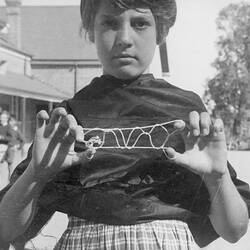Summary
Alternative Name(s): Knucklebone Jacks, Astragali, Astragalus, Talus
Set of 10 knucklebones (or, more likely, two sets of five) - one natural sheep bones, the other plastic.
Knucklebones, or Jacks, is an ancient game, dating back to prehistoric times. The first jacks were natural materials - animal bones, stones, seeds and shells. Sheep's knucklebones were the most common type of jacks in Australia during the first half of this century, and children would colour them by boiling them in water with ink or dye. During the 1950s, mass-produced plastic knucklebones became available. These objects are examples of the very earliest type of mass-produced plastic replica knucklebones used by Australian children to play the game of Jacks. The size, shape and weight of real sheeps' knucklebones were replicated, in contrast to later versions which are much smaller and lighter.
The Australian Children's Folklore Collection is unique in Australia, documenting contemporary children's folklore across Australia and in other countries reaching back to the 1870s. The Collection has a strong component of research material relating to Victoria.
Physical Description
Two sets of knucklebones, one set is real sheep's bones, the other consists of plastic replicas. There are five in each set. The sheep knucklebones are in their natural state, uncoloured, and have been well cleaned. The plastic replicas are small, light and coloured - two red, one yellow, two cream-coloured.
More Information
-
Collection Names
-
Collecting Areas
-
Acquisition Information
Cultural Gifts Donation from Dr June Factor, 18 May 1999
-
Acknowledgement
Donated through the Australian Government's Cultural Gifts Program.
-
Classification
-
Category
-
Discipline
-
Type of item
-
Exhibition Collection Management
30 mm (Length), 24 mm (Width), 19 mm (Height)
various sizes; largest given; 2 sets of 5
-
Keywords
Children's Folklore, Children's Play, Farm Animals, Food Technology, Games, Livestock, Sheep, Making History - Australian Childrens Folklore

